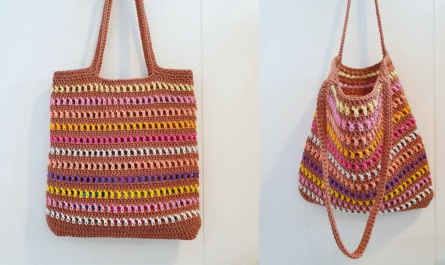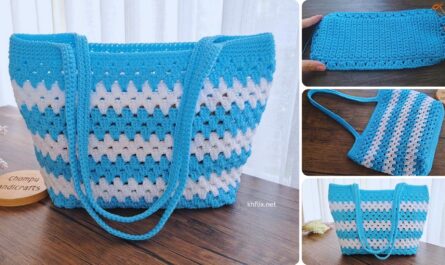Creating a custom, multi-color crochet sling bag is a fantastic way to add a unique and practical accessory to your wardrobe. A sling bag is typically designed to be worn across the body, making it a comfortable and secure option for carrying essentials. This tutorial will guide you through crocheting a sturdy sling bag with a textured body, vibrant horizontal stripes, a functional flap, and an integrated, comfortable strap.
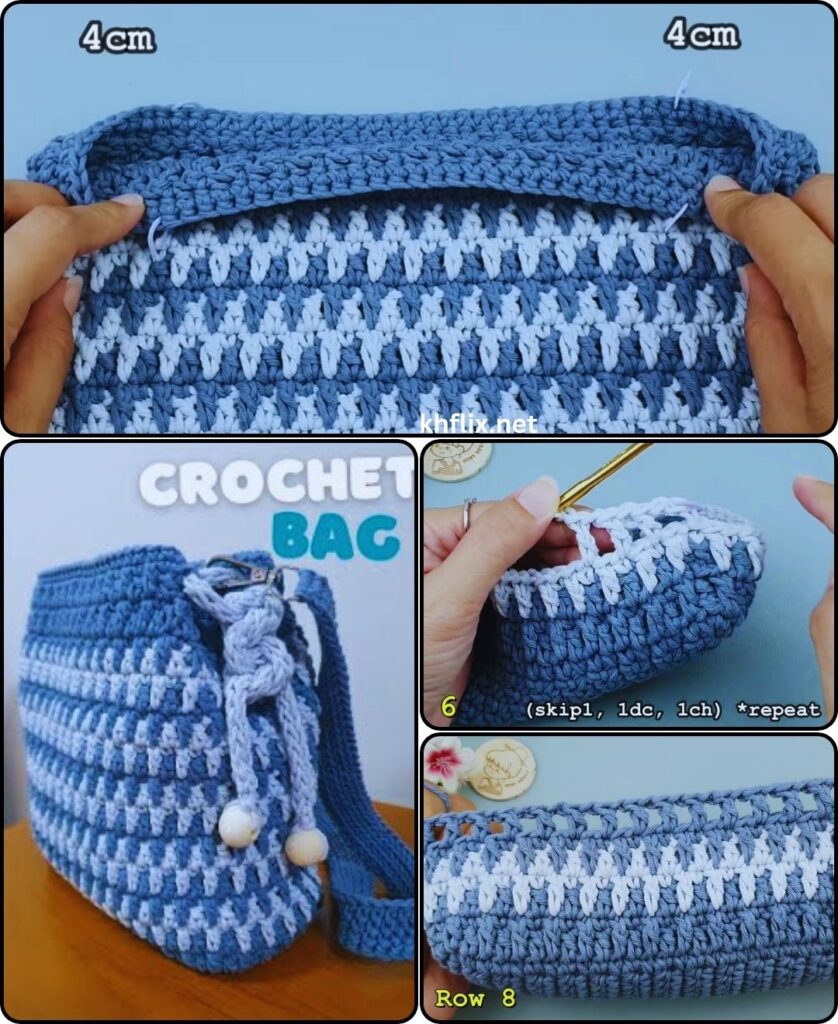
Crochet Sling Bag Tutorial: Multicolor Design
Project Overview: This pattern constructs a medium-sized, rectangular-shaped sling bag. It begins with a flat oval base, builds up a durable body using dense stitches with eye-catching color changes, features a convenient flap closure, and includes a seamlessly integrated, long strap for cross-body wear.
Skill Level: Intermediate (Requires a comfortable understanding of basic crochet stitches, working in the round and in rows, increasing, managing color changes neatly, and shaping).
Finished Bag Dimensions (Approximate):
- Base: 9.5 inches (24 cm) long x 3.5 inches (9 cm) wide
- Bag Height (excluding flap): 8.5 inches (21.5 cm)
- Flap Depth: 4 inches (10 cm)
- Strap Length: Approximately 50-55 inches (127-140 cm) – adjustable
Materials You’ll Need:
- Yarn:
- Worsted Weight (Medium #4) Cotton or Sturdy Acrylic Yarn: Approximately 600-700 yards (550-640 meters) total.
- Color A (Main/Base): Approx. 250-300 yards (e.g., Navy, Black, Rust Brown).
- Color B (Stripe 1): Approx. 100-120 yards (e.g., Mustard Yellow, Olive Green).
- Color C (Stripe 2): Approx. 100-120 yards (e.g., Cream, Dusty Rose).
- Color D (Stripe 3/Optional): Approx. 80-100 yards (e.g., Teal, Burnt Orange).
- Why these yarns? Cotton is excellent for bags due to its durability, good stitch definition, and minimal stretch. Sturdy acrylic yarns are also a great, affordable alternative, offering a wide range of colors. Avoid very soft, fuzzy, or overly stretchy yarns if you want your bag to hold its shape well.
- Crochet Hook:
- Size H/5.0mm (or the hook size that helps you achieve the recommended gauge, ensuring a dense and sturdy fabric suitable for a bag).
- Yarn Needle (Tapestry Needle): Essential for weaving in all loose yarn ends.
- Scissors
- Stitch Markers (Highly Recommended): To mark the beginning of rounds and specific points for strap placement.
- Optional:
- Fabric for lining (about 1/2 to 1 yard, depending on bag size).
- Sewing machine or hand-sewing needle and matching thread (if adding a lining).
- Magnetic snap closure (1 set), button, or a zipper for the flap.
Gauge (Crucial for Consistent Bag Size!):
Achieving the correct gauge is very important for the final size and structure of your sling bag.
With Color A and your H/5.0mm hook, working in half double crochet (hdc):
- 14 hdc = 4 inches (10 cm) wide
- 11 hdc rows = 4 inches (10 cm) high
Your fabric should feel firm and dense. If your swatch is larger than the specified measurements, try going down a hook size. If it’s smaller, try going up a hook size.
Abbreviations Used:
- ch: chain
- sl st: slip stitch
- sc: single crochet
- hdc: half double crochet
- st(s): stitch(es)
- inc: increase (work 2 stitches into the same stitch)
- BLO: back loop only
- FO: fasten off
- RS: Right Side
- WS: Wrong Side
Understanding Bag Construction & Multicolor Stripes:
- Bag Base: We’ll start by crocheting a flat, oval shape, which forms the sturdy foundation for the bottom of your bag.
- Bag Body: The sides of the bag are then built upwards from this base, primarily using the half double crochet stitch to create a solid, durable fabric.
- Multicolor Stripes: To achieve the vibrant multicolor design, you’ll change yarn colors at the end of specific rounds.
- Flap: The flap is crocheted directly onto the top back edge of the bag.
- Sling Strap: The strap is crocheted directly from the sides of the bag, making it fully integrated and very strong.
How to make neat Color Changes for Stripes:
- When you are working the very last stitch of the round with the current color, stop when you have 2 loops left on your hook.
- Drop the current color.
- Pick up the new color, yarn over with the new color, and pull it through the remaining 2 loops on your hook to complete the stitch.
- Continue working the next round with the new color.
- After completing the color change, you can cut the old color yarn, leaving a tail of about 4-6 inches (10-15 cm) to weave in securely. Avoid carrying unused yarns up the side of the bag, as they can show through the stitches and make the edges bulky.
Let’s Start Crocheting Your Multicolor Sling Bag!
Part 1: The Bag Base (Color A)
We’ll begin by creating the oval base of your sling bag. For this section, we’ll work in continuous rounds (meaning you won’t join with a slip stitch at the end of each round). Remember to use your stitch marker to indicate the first stitch of every round.
- With Color A and your H/5.0mm hook, ch 34. (This chain length determines the primary length of your bag. You can adjust it to make your bag longer or shorter, but be mindful that it will affect the total stitch count in subsequent rounds.)
- Round 1: Work 2 hdc in the 3rd chain from the hook. (This counts as your first increase at one end of the oval). Work 1 hdc in each of the next 31 chains. Now, work 4 hdc in the very last chain. (This creates the smooth curve for the other end of your oval). Next, working down the opposite side of your foundation chain, work 1 hdc in each of the next 31 chains. Finally, work 2 hdc in the very last chain. (This is the same chain where you worked your initial 2 hdc, completing the oval). (You should now have a total of 72 hdc).
- Place your stitch marker in the very first hdc of this round.
- Round 2: Work 2 hdc in the first stitch. Work 1 hdc in the next stitch. Work 2 hdc in the next stitch. Work 1 hdc in each of the next 31 stitches. Work 2 hdc in the next stitch. Work 1 hdc in the next stitch. Work 2 hdc in the next stitch. Work 1 hdc in each of the next 31 stitches. Work 2 hdc in the next stitch. Work 1 hdc in the next stitch. (Total: 78 hdc).
- Round 3: Work 2 hdc in the first stitch. Work 1 hdc in each of the next 2 stitches. Work 2 hdc in the next stitch. Work 1 hdc in each of the next 33 stitches. Work 2 hdc in the next stitch. Work 1 hdc in each of the next 2 stitches. Work 2 hdc in the next stitch. Work 1 hdc in each of the next 33 stitches. Work 2 hdc in the next stitch. Work 1 hdc in each of the next 2 stitches. (Total: 84 hdc).
- At this point, your base should be a sturdy oval, roughly 9.5 inches (24 cm) long and 3.5 inches (9 cm) wide. It might curl slightly upwards, which is normal as it will form the bottom of your bag.
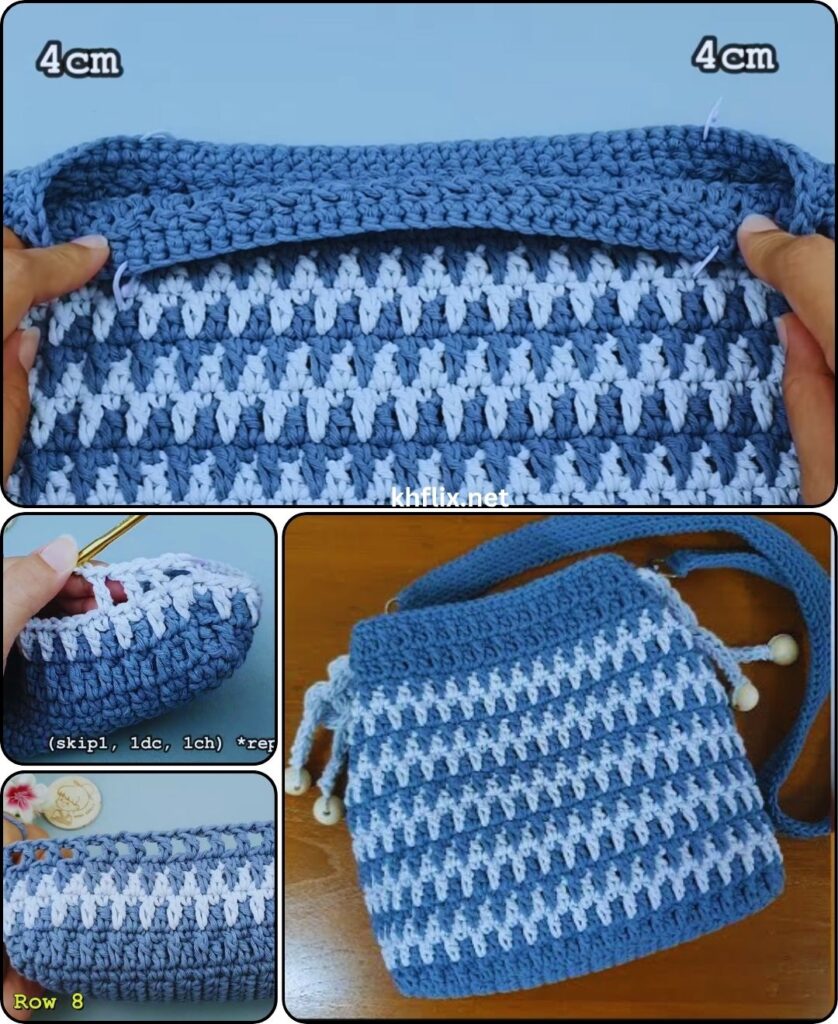
Part 2: The Bag Body (Multicolor Stripes)
Now that the base is complete, we’ll build the sides of the bag straight upwards. The first round in this section creates a sharp, defined edge where the bottom of the bag meets the sides.
- Round 4 (Creating the base edge): Work 1 sc in the BLO (back loop only) of each stitch around. (Total: 84 sc).
- Working in the BLO creates a distinct horizontal ridge around the base, making the bag’s bottom stand out and encouraging the sides to stand up straight. Remove your stitch marker from the previous round and place it in the first sc of this current round.
- Round 5 (Start Body – Color A): Work 1 hdc in each stitch around. (Total: 84 hdc).
- Remove your stitch marker and place it in the first hdc of this round.
- On the very last hdc of this round, remember to change to Color B on the last pull-through for a neat color transition.
- Rounds 6-7 (Color B): Work 1 hdc in each stitch around. (Total: 84 hdc per round).
- On the very last hdc of Round 7, change to Color C.
- Rounds 8-9 (Color C): Work 1 hdc in each stitch around. (Total: 84 hdc per round).
- On the very last hdc of Round 9, change to Color D (if using).
- Rounds 10-11 (Color D – Optional): Work 1 hdc in each stitch around. (Total: 84 hdc per round).
- On the very last hdc of Round 11, change to Color A.
- Rounds 12-13 (Color A): Work 1 hdc in each stitch around. (Total: 84 hdc per round).
- On the very last hdc of Round 13, change to Color B.
- Repeat Rounds 6-13 (continuing the stripe sequence of 2 rounds each of B, C, D (optional), A) until the bag body reaches your desired height (e.g., 8.5 inches / 21.5 cm tall from the base edge).
- Aim to end on a Color A round (or the color you want your flap/strap to be).
- On the very last hdc of the final body round, sl st (slip stitch) to the first hdc of the round to join cleanly. This creates a neat, even top edge for your bag.
Part 3: The Flap (Color A or chosen accent color)
The flap will be crocheted directly onto the back top edge of the bag. Lay your bag flat and identify the center back (the side directly opposite where you ended your rounds, or simply one of the longer sides). The flap will cover roughly half of the bag’s opening.
- From the top edge of the bag, count 28 stitches from one side seam marker, across the top edge. Join Color A (or your chosen flap color) with a sl st in this 28th stitch.
- Row 1 (RS): Ch 1. Work 1 sc in the same stitch and in the next 41 stitches across the top edge. (Total: 42 sc).
- Ch 1, turn.
- Rows 2-10 (WS & RS): Work 1 sc in each sc across. (Total: 42 sc).
- Ch 1, turn at the end of each row.
- Row 11 (Flap Shaping): Work sc2tog (single crochet 2 together) over the first 2 stitches. Work 1 sc in each stitch until 2 stitches remain. Work sc2tog over the last 2 stitches. (Total: 40 sc).
- Ch 1, turn.
- Row 12: Work 1 sc in each sc across. (Total: 40 sc).
- Ch 1, turn.
- Repeat Rows 11 and 12 until your flap is about 4 inches (10 cm) deep and has approximately 30 stitches remaining. (This will be about 4-6 more rows of shaping).
- FO, leaving a long tail if you want to use it for an optional button.
Optional: Button Loop (if using a button closure) If using a button, locate the center point of the flap’s end. Join yarn. Ch 8-12 (adjust to fit your button), sl st to the same point. FO. Weave in ends.
Part 4: The Sling Strap (Color A or chosen accent color)
The strap will be integrated, coming from the sides of the bag. You’ll need to figure out where to attach it. Lay your bag flat. The flap is on the back. The strap should ideally connect from the top corners of the bag’s sides.
- Marking Strap Attachment Points: Find the center of each side edge of your bag’s opening. From each center point, count 2 stitches towards the front of the bag and place a stitch marker. Count 2 stitches towards the back of the bag (towards the flap) and place another stitch marker. These four markers (two on each side) indicate where your strap will begin.
- First Strap Section (Side 1):
- Join Color A (or strap color) with a sl st to the stitch with the front-most stitch marker on one side of the bag.
- Row 1: Ch 1. Work 1 sc in the same stitch and in the next 3 stitches (between the two markers). (Total: 4 sc).
- Ch 1, turn.
- Row 2: Work 1 sc in each sc across. (Total: 4 sc).
- Ch 1, turn.
- Repeat Row 2 until this strap section measures approximately 25-27 inches (63-68 cm) long. This forms half of your total sling strap. Do NOT FO. Keep loop on hook.
- Second Strap Section (Side 2):
- Go to the other side of the bag. Join Color A (or strap color) with a sl st to the stitch with the front-most stitch marker on this second side.
- Repeat Row 1 and Row 2 of the First Strap Section until this second strap section also measures approximately 25-27 inches (63-68 cm) long.
- Do NOT FO.
- Joining the Strap Sections:
- With the loop still on your hook from the end of the second strap section, ch 4 (this creates a short connecting piece between the two main strap sections).
- Now, take the end of your first strap section (where you left the loop) and sl st into the first sc of that section. Continue working 1 sc into each of the 4 stitches along the edge of the first strap section.
- You are now crocheting a continuous loop for the strap. Continue working 1 sc into each of the 4 chains you made.
- Then work 1 sc into each of the 4 stitches along the edge of the second strap section.
- Sl st to the first sc to join the strap into a complete loop. This creates a continuous, sturdy strap.
- Optional: Reinforce Strap: Work 1-2 more rounds of sc around the entire newly formed strap loop for extra durability and thickness.
- FO, leaving a tail to weave in.
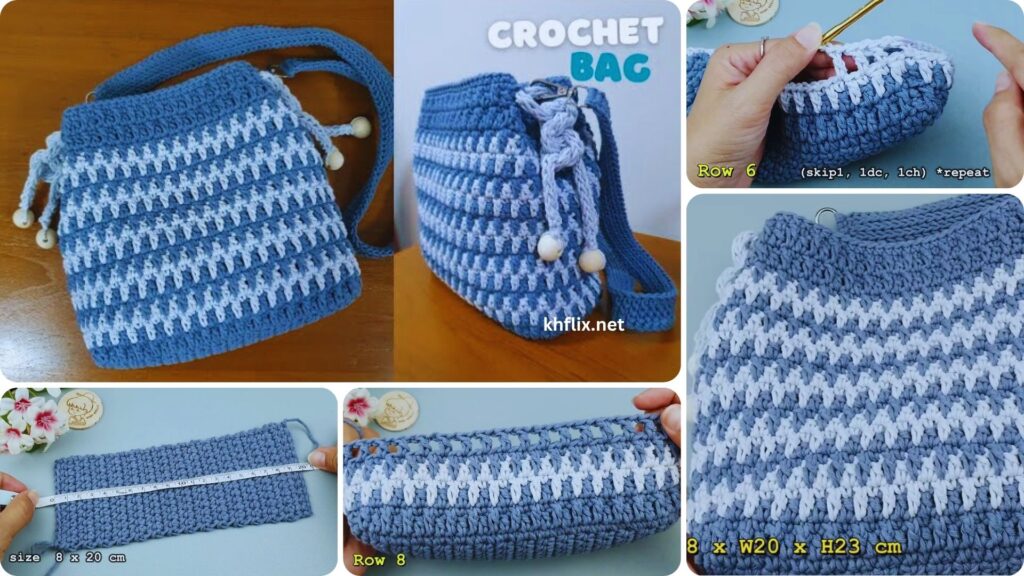
Part 5: Finishing & Assembly
- Weave in All Ends: This is a crucial step for a clean, professional, and durable finish. Use your yarn needle to thoroughly weave in all loose yarn tails from the bag body, flap, and strap. Be sure they are secured well and hidden.
- Optional: Add a Fabric Lining (Highly Recommended for Durability & Functionality):
- A fabric lining will protect your crocheted stitches from stretching or catching on items, prevent small items from slipping through any tiny gaps in the crochet work, and give your bag a more polished, professional finish.
- Measure: Measure the exact circumference of your crocheted bag opening and the height of the crocheted bag body.
- Cut Fabric: Cut a piece of sturdy fabric (like cotton broadcloth, quilting cotton, or linen) that is 1 inch (2.5 cm) wider than the bag’s circumference and 2 inches (5 cm) taller than the bag’s height.
- Sew Lining: Fold the fabric in half (right sides together) and sew up the side seam and the bottom seam. If desired, create boxed corners on the bottom of the lining to match the bag’s oval base. Hem the top edge of the lining by folding it over twice (e.g., 1/2 inch then another 1/2 inch) and pressing or sewing it down.
- Insert & Attach: Carefully place the finished fabric lining inside your crocheted bag, ensuring it fits snugly. Hand-stitch the top hem of the lining to the inside top edge of your crocheted bag using small, neat stitches that don’t show through to the outside.
- Attach Closure:
- Magnetic Snap: Sew a magnetic snap closure (1 set) to the underside of the flap and the corresponding place on the front of the bag body.
- Button: If you created a button loop, sew your chosen button securely onto the front of the bag body, aligning it with the loop on the flap.
Your vibrant, handmade, multi-color crochet sling bag is now complete and ready for all your adventures!
Tips for Success & Customization:
- Yarn Choice is Key: For a sling bag that holds its shape and withstands daily use, choose a yarn that is durable and has minimal stretch. Cotton, mercerized cotton, or a sturdy acrylic are excellent choices.
- Consistent Tension: Maintaining even tension throughout your crocheting is crucial. This will ensure your stitches are uniform, your fabric is smooth, and your bag holds its shape well.
- Neat Color Changes: Take extra care when changing colors to ensure the transitions are crisp and clean, without visible bumps or gaps. Weave in ends as you go, or immediately after completing each stripe, to keep things tidy.
- Sizing Up/Down:
- Base: Adjust your starting chain for the initial length. You can also add or remove increase rounds to change the base width, always maintaining the oval increase pattern.
- Body Height: Simply add or remove rounds in Part 2 until you reach your desired height.
- Strap Length/Width: Adjust the number of chains for the initial length and the number of single crochet rows for the width.
- Stripe Variations:
- Experiment with different stripe widths: change colors every 1 round for thinner stripes, or every 3-4 rounds for broader bands.
- Use more (or fewer) colors to create your unique palette.
- Try different color sequences for varied effects.
- Other Stitch Patterns: While hdc provides a solid fabric, you could explore other dense stitches like single crochet (sc), moss stitch (alternating sc and ch 1), or a textured stitch like the seed stitch (alternating sc and dc). Always ensure the fabric remains firm for a bag.
Enjoy creating and using your unique sling bag!



